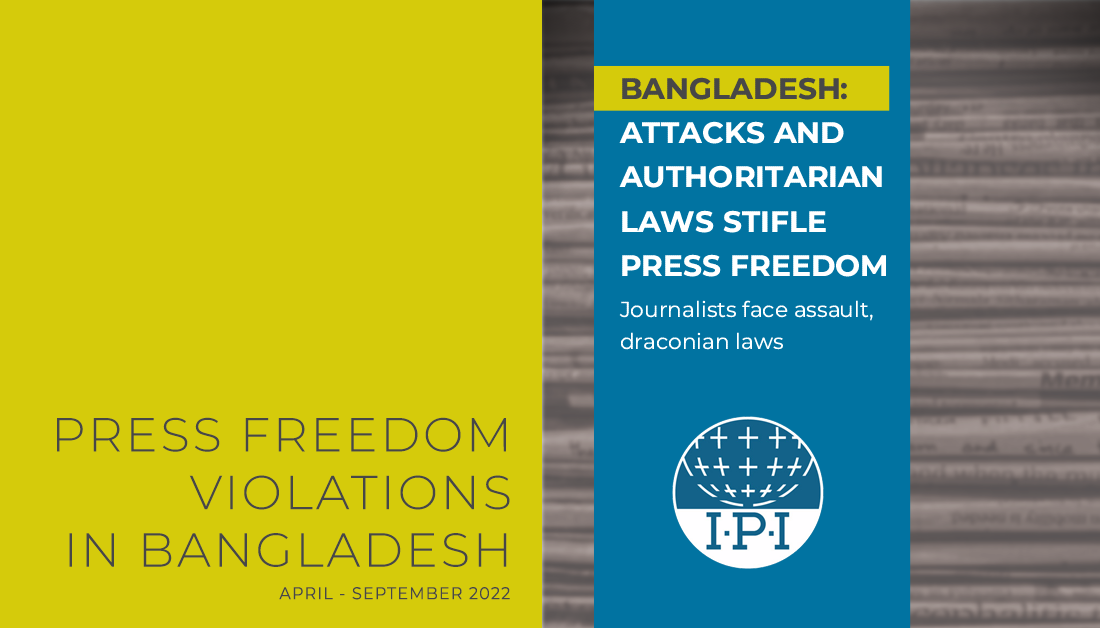Journalists in Bangladesh operate in a hostile and dangerous environment, often facing physical attacks and threats, legal harassment and arrests, as well as censorship and surveillance. Draconian laws restricting independent journalism continue to choke press freedom and democracy.
IPI identified at least 30 press freedom violations in a six-month period between April and September 2022, which included cases of physical attacks on journalists, as well as arrests and the introduction of restrictive cyber regulations.
Two journalists were killed in Bangladesh in this period. On April 13, journalist Mohiuddin Sarkar Nayeem was shot and killed near the Bangladesh-India border by alleged drug traffickers. He had previously reported on drug trafficking in the area. On July 7 journalist Hasibur Rahman Rubel, working for the daily newspaper Dainik Kushtiar Khobor, was found dead in western Bangladesh after going missing. The journalist’s family said Rubel was deliberately killed for his work as a reporter.
At least three journalists were charged under the Digital Services Act (DSA), which has been used to target hundreds of journalists since it was introduced in 2018. During this monitoring period, the government proposed restrictive new measures for digital and OTT platforms that would further stifle press freedom. The draft regulations would prohibit digital and social media platforms from displaying content threatening the “unity, integrity, defense, security, or sovereignty of Bangladesh” and content that could be deemed critical of the national anthem or flag. It would also require intermediaries, such as WhatsApp and Signal, to enable traceability and the identification of any suspects deemed to be violating the guidelines outlined in the draft regulations.
Download the full fact sheet here (PDF file)
IPI monitors and collects data on press freedom violations in Bangladesh as part of an ongoing cross-border project that brings together partner media outlets in India, Pakistan, Bangladesh, and Nepal to create public awareness about attacks on journalists and highlight the erosion of press freedom across South Asia.
[content_boxes settings_lvl=”child” layout=”clean-horizontal” columns=”1″ icon_align=”left” title_size=”18″ title_color=”” body_color=”” backgroundcolor=”#d5cb0b” icon_circle=”” icon_circle_radius=”” iconcolor=”#d5cb0b” circlecolor=”#d5cb0b” circlebordercolor=”#d5cb0b” circlebordersize=”” outercirclebordercolor=”#d5cb0b” outercirclebordersize=”” icon_size=”” icon_hover_type=”” hover_accent_color=”” link_type=”” link_area=”” link_target=”” animation_delay=”” animation_offset=”” animation_type=”0″ animation_direction=”down” animation_speed=”0.1″ margin_top=”0″ margin_bottom=”0″ class=”” id=””][content_box title=”IPI Monitoring Reports (April-September 2022)” icon=”” backgroundcolor=”#d5cb0b” iconcolor=”#000000″ circlecolor=”#d5cb0b” circlebordercolor=”” circlebordersize=”” outercirclebordercolor=”” outercirclebordersize=”” iconrotate=”” iconspin=”no” image=”” image_width=”35″ image_height=”35″ link=”” linktext=”” link_target=”_self” animation_type=”0″ animation_direction=”down” animation_speed=”0.1″]
[checklist icon=”fa-calendar” iconcolor=”#000000″ circle=”no” circlecolor=”” size=”17px” class=”” id=””]
[li_item icon=”fa fa-cloud-download”]BANGLADESH[/li_item]
[li_item icon=”fa fa-cloud-download”]INDIA[/li_item]
[li_item icon=”fa fa-cloud-download”]NEPAL[/li_item]
[li_item icon=”fa fa-cloud-download”]PAKISTAN[/li_item]
[li_item icon=”fa-user”]Questions? Please write to abrouillette(at)ipi.media.[/checklist]
[/content_box][/content_boxes]
